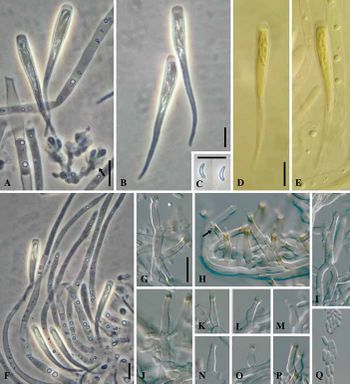Calosphaeria pulchella
From Pestinfo-Wiki
| Literature database |
|---|
| 7 articles sorted by: |
| • year (recent ones first) |
| • research topics |
| • countries/regions |
| • host plants |

Calosphaeria pulchella - A) ascogenous hyphae with asci; B, D–E) asci; C) ascospores; F) paraphyses intermingled with asci; G, J) conidiophores; H–I, K–P) phialides with pigmentation around the necks (arrow in H); Q) conidia - scale bars: A–Q = 10 µm, scale bar for G applies to H–Q (click on image to enlarge it)
Authors: Lizel Mostert, Johannes Z. Groenewald, Richard C. Summerbell, WalterGams and Pedro W.Crous, photographs A-F by M. Réblová
Source: Studies in Mycology (2006) 54, p. 102
Authors: Lizel Mostert, Johannes Z. Groenewald, Richard C. Summerbell, WalterGams and Pedro W.Crous, photographs A-F by M. Réblová
Source: Studies in Mycology (2006) 54, p. 102
Calosphaeria pulchella (Pers.) J. Schröt. 1897
This fungus is widely distributed and causes canker, dieback and vascular necroses on cherry and other Prunus species. Leaves may dry up on affected branches without defoliation. The disease can cause significant damage in some countries. It spreads through rain splashes and irrigation systems (Trouillas et al., 2012) but also with pruning tools.